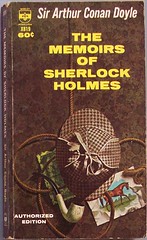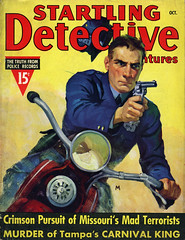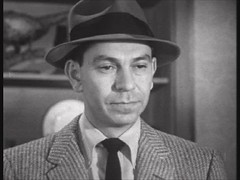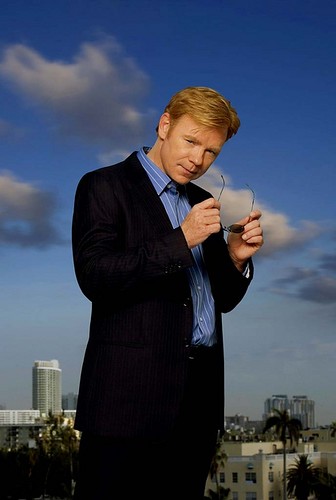In my defense, I blame the Academy of Motion Picture Arts & Sciences for my recent rush of calculations. They recently adopted a few changes in the Best Picture category that have greatly complicated matters. First they decided to double the number of movies nominated for the top prize from five to ten. Okay easy enough, just print bigger ballots. Then they noticed that a movie could garner as little as 10.01% of the vote and win the most coveted award in Hollywood. Put it in other words, given the Academy has about 6,000 members, 5,400 of them could hate one of the ten nominated movies, but if 601 people vote for it it would be recorded as the best film of the year.
Rather than allow a highly fractured vote lead to an embarrassing result, someone proposed a new kind of ballot called "preferential voting" or "instant runoff". This basically means the Academy members rank the ten nominated film from their number one choice down. (On a personal note, I recently participated in an instant runoff election, and I can say from experience it was fun, easy and seemed like it could work in more elections.) Once the ballots are collected, the fine folks at PriceWaterhouse Coopers -a barrel making firm if I understand the definition of cooper correctly- then check to see if any film got a majority of the first place votes. Unless a film is an instant winner (unlikely to happen unless one film has an overwhelming level of support), the tabulators start weeding out the nominees that received few first place votes and redistributing their votes among the remaining films.
Since this is all a little confusing, I think it might be best to walk through a simulation of how the vote might break down among this year's Best Picture nominees. The inimitable Nate Silver -the only other person on Internet I could find nerdy enough to mix math with the Oscars- performed a similar exercise already. However he crunched his numbers before the nominees were announced, though he did accurately predicted nine of the ten. Also he used critics rankings, because he could find reliable data for them, instead of attempting to gauge the opinion of the AMPAS voters, a much trickier proposition. Fortunately for you, I don't have Silver's commitment to accuracy to worry about or his stellar reputation for predictions to preserve, so I can make a foolhardy attempt to predict how members of the Academy might rank the films. I will combine my knowledge of past Oscar races, my understanding of the AMPAS membership, and a watchful eye to the current dynamics of the awards season to estimate the level of support each nominee can expect.
We can begin breaking down the vote distribution by breaking down the membership of the Academy. Between the 6,000 AMPAS members and the 15 branches within the Academy, I can identify 4 major voting blocs, each based on different definitions you can use to determine the Best Picture of the year.
First you have those voters who believe that the Best Picture award should go the grandest film of the year. They like seeing movies you could describe as "epic" winning the top prize, films like Gladiator and The Lord of the Rings. This group probably contains mostly producers and directors, with some cinematographers, writers and a few actors mixed in. I estimate these voters account for about 35% of the total number of Best Picture votes.
Balancing out the first group you have those who believe that "best picture" means "most moving". They want to reward the movies that have the strongest emotional impact. Recently these voters likely supported Best Picture winners like Million Dollar Baby and Slumdog Millionaire. I would say a lot of the actors in the Academy vote with this block along with some of the writers and directors, probably a fair number of the artistic members who do art direction, makeup, and costuming too. These voters seem to represent around 35% of the vote as well.
The third major group comes from the less famous branches of AMPAS, the ones who are nominated in the so called "artistic and technical categories". Since every member can vote in the Best Picture category this undervalued lot can have a powerful impact on the race. They tend to hold that the Oscar brand should fall to those films they deem the most well made or best crafted. The last two Best Pictures, The Hurt Locker and No Country For Old Men, seem to have had strong support from this bloc. All told they likely comprise 25% or so of the Academy.
Finally, you have a small group that can play a big role if there is ever a close race. These are producers, publicists, and studio executives who simply -some might say cynically- contend that the "best" movies are the one's that make the most money. So their rankings of the years films pretty much mirror the final box office earnings. Their support helped put Titanic over the top to earn a record number of Oscars. Last year they probably supported Avatar, but the other factions trumped them. They probably add up to no more than 5% of the votes available for Best Picture.
So if you divide the Academy into these four groups, you likely can guess which groups would vote for which nominees, and therefore how much support each nominee has. It is important to remember that each group will likely vote for more than one film, and many nominees will receive votes from more than one group. Also, I will assume that each group has a selection of movies that they all rank above the others. So you when a movie that had a share of the "most touching" vote is eliminated it's votes will probably go the other emotionally powerful movies before they go anywhere else. With all of that explained, I think we can begin breaking down the actual votes.
Grandest Picture Bloc- 35% of the total 1st place votes
- The King's Speech: 35% of the bloc vote = 12.25% of the total vote
- The Social Network: 30% bloc = 10.5% total
- Inception: 20% bloc = 7% total
- True Grit: 10% bloc = 3.5% total
- Winter's Bone: 5% bloc = 1.75% total
These are all the options from among the nominees which seem to portray a grand vision, or tell an ambitious story. In some cases this is because of the amount of work involved (for period pieces like True Grit or The King's Speech). Sometimes it its because of the level of technical sophistication that the filmmakers employed (such as in manking The Social Network or Inception). Also a film could just have overachieved and accomplished a lot with relatively meager means (as I believe some will argue Winter's Bone managed to do).
Most Powerful Movie Bloc- 35% of the total 1st place votes
- The King's Speech: 40% of the bloc vote = 14% of the total vote
- The Fighter: 20% bloc = 7% total
- Black Swan: 15% bloc = 5.25% total
- The Kids Are All Right: 10% bloc = 3.5% total
- Winter's Bone: 5% bloc = 1.75% total
- Toy Story 3: 5% bloc = 1.75% total
- 127 Hours: 5% bloc = 1.75% total
Among this group you can find the nominees that have been most praised for the emotional power the convey. Here you will notice some overlap with the first group, most notably The King's Speech. While other films from the first group have been left out. I am yet to hear anyone call either Inception or The Social Network "the most touching movie of the year".
Best Made Film Bloc- 25% of the total 1st place votes
- The Social Network: 30% of the bloc vote = 7.5% of the total vote
- The King's Speech: 20% bloc = 5% total
- The Fighter: 15% bloc = 3.75% total
- True Grit: 15% bloc = 3.75% total
- Inception: 10% bloc = 2.5% total
- Winter's Bone: 5% bloc = 1.25% total
- 127 Hours: 5% bloc = 1.25% total
Now all of the nominees have to have been well crafter movies to even be considered for an Oscar. However, I believe this list contains those pictures who derive the biggest chunk of their merit from their technical values. Each of these nominees has impressive filmmaking elements that made it stand out from the other movies released in 2010.
Biggest Hit Bloc- 5% of the total 1st place votes
- Inception: 60% of the bloc vote = 3% of the total vote
- Toy Story 3: 40% bloc = 2% total
Finally this group has only two movies with big box office earnings to vote for. In most years I would imagine the vote might be pretty monolithic -whichever nominee earned the most gets the most votes. However this year I think the voters will split between the highest grossing movie of the year, Toy Story 3, and the biggest money-maker among the live action films. I say this because some members of the Academy still believe that animated films should not be compared to live action films. They involve different kinds of filmmaking and they generally aim to accomplish different goals. Therefore any method of comparison, even total grosses, can't be easily evaluated between animated and live action films. Do you reward Toy Story 3 for selling so many tickets, especially when you earn less off a children's ticket? Do you support Inception for bringing droves of adults to the cinema, something Hollywood has struggled to do for years? There's no easy answer, so I predict a split vote here.
Let's put all that information into one chart, so you can see how much of the vote each nominee received.
Total Vote- Round 1
- The King's Speech: 31.25%
- The Social Network: 18%
- Inception: 12.5%
- The Fighter: 10.75%
- True Grit: 7.25%
- Black Swan: 5.25%
- Winter's Bone: 4.75%
- Toy Story 3: 3.75%
- The Kids Are All Right: 3.5%
- 127 Hours: 3%
None of the nominees have a majority, though The King's Speech has a huge lead over all the others. That means there is no instant winner and the voting no goes to multiple rounds. In each round the film with the lowest share of the 1st place vote is eliminated it's votes are then redistributed to those nominess that remain. The votes are spread out by going down the ballot to the highest ranked film still in contention and giving that film an additional 1st place vote.
The first film to go is 127 Hours. I know it feels like losing an arm to lose one of these nominees (rimshot!), but that is how the process works. We start by identifying where the votes for 127 Hours came from then determine which of the survivors profit from the departure of this film.
Some of the Most Powerful Movie vote, 5%, went to 127 Hours, so we can split that among some of the other touching films in contention. This is how I expect those votes to break down:
1st Place- 127 Hours
- Black Swan: 30%
- The Fighter: 30%
- The King's Speech: 20%
- Winter's Bone: 20%
To clarify what these numbers represent, I am dividing up just 1.75% of the total 1st place votes. When I say The King's Speech gets 20% of the votes from people who judged 127 Hours to be the emotionally touching movie of the year, I am say one-fifth of 1.75% of the Academy's 6,000 members, or about 21 people, would now have their 1st place vote go to The King's Speech instead of their original pick.
Of cour 127 Hours got some votes for being the best made film of the year as well. Here I have a different pool of films among which to divide the 1st place votes. I would predict the votes would spread out like:
1st Place- 127 Hours
- The Social Network: 30%
- The Fighter: 30%
- Winter's Bone: 20%
- The King's Speech: 10%
- Inception: 10%
After I calculate the effect these changes have on the total 1st place vote distribution, I can make an updated chart of the standings.
Total Vote- Round 2
- The King's Speech: 31.725%
- The Social Network: 18.375%
- Inception: 12.625%
- The Fighter: 11.65%
- True Grit: 7.25%
- Black Swan: 5.775%
- Winter's Bone: 5.35%
- Toy Story 3: 3.75%
- The Kids Are All Right: 3.5%
-
Since we still lack any nominee with over 50% of the total vote the process continues. Next on the chopping block we have the critically acclaimed dramedy, The Kids Are All Right. Since this fillm got all of it's support from one bloc of voters, the Most Powerful Movie crowd, it is pretty easy to divvy up the votes appropriately. I imagine that the supports of The Kids Are All Right, a largely comedic film with an indy vibe, will have ranked other films that are humorous or independent highly. Thus:
1st Place- The Kids Are All Right
- The King's Speech: 50%
- Toy Story 3: 30%
- Winter's Bone: 20%
That brings our updated standings to:
Total Vote- Round 3
- The King's Speech: 33.475%
- The Social Network: 18.375%
- Inception: 12.625%
- The Fighter: 11.65%
- True Grit: 7.25%
- Black Swan: 5.775%
- Winter's Bone: 6.05%
- Toy Story 3: 4.8%
-
-
Now we move on to Toy Story 3 and it's supporters. The folks who voted for it because it was the highest earning movie of the year are easy to account for. All of their 1st place votes would just go to the next big money maker, Inception. The people who held it as the most touching of the nominees will require a more involved breakdown. This block no longer represents just the 1.75% of the Academy that gave it a 1st place vote originally. Now we also have to spread out the votes it received as a result of other films getting dropped. That means we now have 2.8% of the vote to work with. (I know that's a staggering amount of change to deal with. You might want to take a second and catch your breath before you move on.) Here is how I would imagine the votes are divided among this group:
1st Place- Toy Story 3
- The King's Speech: 70%
- The Fighter: 10%
- Black Swab: 10%
- Winter's Bone: 10%
Factoring in those adjustments, and the earlier bump to Inception's standings, we have these updated standings:
Total Vote- Round 4
- The King's Speech: 35.435%
- The Social Network: 18.375%
- Inception: 14.625%
- The Fighter: 11.93%
- True Grit: 7.25%
- Black Swan: 6.055%
- Winter's Bone: 6.33%
-
-
-
In an interesting twist, Black Swan, which started with more of the 1st place vote share than Winter's Bone, is actually the next movie eliminated. Please note that all of this has been my speculation. I cannot actually know if more members of the Academy ranked Winter's Bone high on their ballot than did for Black Swan. I do however believe that this sort of change in the standings is possible, and even likely, once you start eliminating nominees and redistributing the vote. Having said that and remembering that only films still active can receive new 1st place votes, this is how I break down the vote:
1st Place- Black Swan
- The King's Speech: 60%
- The Fighter: 20%
- Winter's Bone: 20%
Those adjustments mean these are the new standings:
Total Vote- Round 5
- The King's Speech: 39.068%
- The Social Network: 18.375%
- Inception: 14.625%
- The Fighter: 13.141%
- True Grit: 7.25%
-
- Winter's Bone: 7.541%
-
-
-
The changing share of the votes bring another intriguing change. Winter's Bone has now lept True Grit as well. This is mostly because True Grit has not gained any new votes from the eliminated movies. Part of this is because a lot of the movies we've dumped drew their support from different sources than True Grit. Another factor is that some films may be widely liked, but not widely loved. This year True Grit seems to be a good example of that. Without many people outside of it's ardent supporters ranking it highly on their ballot, it doesn't stand much of a chance of winning Best Picture.
The voters who considered True Grit the biggest and most ambitious movie of the year probably split their other top votes like this:
1st Place- True Grit
- The King's Speech: 40%
- Inception: 30%
- The Social Network: 20%
- Winter's Bone: 10%
While those who rated True Grit as the best crafted film likely have their support spread like this:
1st Place- True Grit
- The King's Speech: 30%
- Inception: 30%
- The Social Network: 20%
- The Fighter: 10%
- Winter's Bone: 10%
I would like to note that in this round I assumed Inception would benefit strongly from the elimination of the only other film with strong action/adventure content. That means the new standings look like this:
Total Vote- Round 6
- The King's Speech: 41.593%
- The Social Network: 19.825%
- Inception: 16.8%
- The Fighter: 13.516%
-
-
- Winter's Bone: 8.266%
-
-
-
Now we have to finally cast aside Winter's Bone. Since it is being removed that means we have a few points to consider when spreading out the ballots it had gained. First we can see that the Grandest Picture bloc has begun to shift. Because the people who rated Winter's Bone high likely are comfortable voting with a smaller skill picture that has a big vision, I predict The King's Speech will benefit more than Inception or The Social Network. Also I expect that the voters in the other corner will favor The King's Speech over The Fighter. I say this because I can look to the trends in the earlier vote distributions. Anytime group of voters that gave a boost to Winter's Bone tended to favor The King's Speech pretty strongly. That translates to a big boost The King's Speech compared to modest gains for the others.
The Grandest Picture vote would divide like this:
1st Place- Winter's Bone
- The King's Speech: 60%
- The Social Network: 30%
- Inception: 10%
The Most Powerful Movie vote would divide thusly:
1st Place- Winter's Bone
- The King's Speech: 70%
- The Fighter: 30%
This is what would happen with the Best Made Film vote:
1st Place- Winter's Bone
- The King's Speech: 40%
- The Social Network: 20%
- The Fighter: 20%
- Inception: 20%
Which means our updated standings would now be this:
Total Vote- Round 7
- The King's Speech: 46.6067%
- The Social Network: 20.83%
- Inception: 17.385%
- The Fighter: 15.1783%
-
-
-
-
-
-
Finally we have reached a point where a movie is within easy striking distance of the 50% mark. That means this next round should be enough to give The King's Speech the golden man-shaped trophy. This is especially true when you acknowledge that The King's Speech is the only film left that had the support of the Most Powerful Movie Bloc, so it now has 35% of the 1st place votes all to itself.
Breaking down the votes from the people who named The Fighter the best crafter movie of the year, I estimate this is how things would stand:
1st Place- The Fighter
- The King's Speech: 40%
- The Social Network: 40%
- Inception: 20%
Add it all up and you finally have a clear winner.
Total Vote- Round 8
- The King's Speech: 58.86%
- The Social Network: 27.78%
- Inception: 18.36%
-
-
-
-
-
-
-
What can we learn from any of this? (Other that I am a very odd duck to devote so much arithmetic to such a trivial matter) The first thing that strikes me is that asking one of ten nominees to get a majority of the vote means it is unlikely any movie will ear the Oscar after only a few rounds of voting. Further I find it interesting that the three films left standing, The King's Speech, The Social Network, and Inception, can each point to an area where they had a strong body of support, the Most Powerful vote, the Best Made vote and the Biggest Hit vote respectively. It would seem those campaigning for any of the nominees would be well served by targeting a demographic that can give you a solid block of votes, then hoping that as films get eliminated you will rise up. Also, I like the fact that in this exercise we saw how Winter's Bone was able to climb the standings by being broadly supported if not having the level of high profile support the others did. This suggest to me that any high quality film could wind up winning Best Picture even if it doesn't have the box office numbers or publicity of other movies.
So does any of this mean anything? Not really, it was mostly an exercise I came up with to amuse myself and hopefully my audience. The only way to know if I am correct in my estimations, and that The King's Speech will walk away as the big winner is to tun in and watch the Oscars on February 27th. I know I'll be watching, and I hope you do to.










